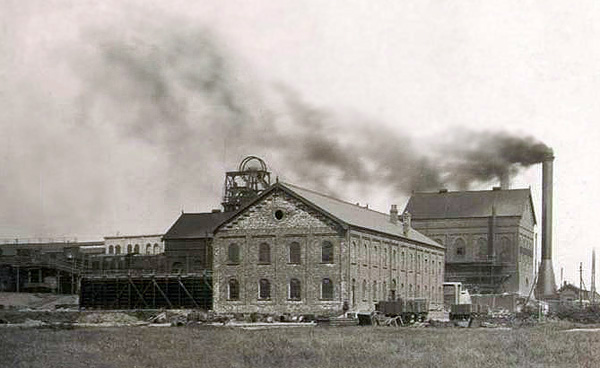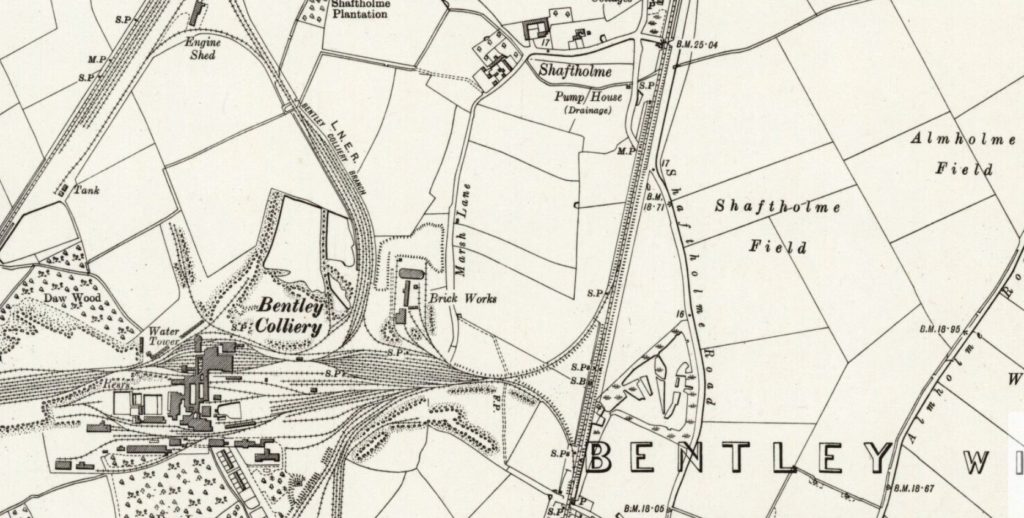 A borehole sunk by the Vivian Boring Co. proved nine feet of coal at a depth of 563 metres at Daw Wood near Doncaster in 1893. In March 1902, Messrs Barber-Walker and Co. Ltd leased a large area around Bentley, from Sir William Cooke, in order to sink shafts to the Barnsley Seam. The company already had collieries working the Top Hard Coal in Nottinghamshire (the same seam as the Barnsley Seam in Yorkshire).
A borehole sunk by the Vivian Boring Co. proved nine feet of coal at a depth of 563 metres at Daw Wood near Doncaster in 1893. In March 1902, Messrs Barber-Walker and Co. Ltd leased a large area around Bentley, from Sir William Cooke, in order to sink shafts to the Barnsley Seam. The company already had collieries working the Top Hard Coal in Nottinghamshire (the same seam as the Barnsley Seam in Yorkshire).
The surface works began in 1903 and a start on sinking the No.2 Shaft was made on the 9th October 1905. Because quicksand was known to exist in the area, it was decided to lower steel tubbing, circled by interlocking piles which ran down the back of a guide ring to prevent them from converging. There were 72 mild steel piles, every 2.4 metres in length which were jacked downwards by applying pressure against the bottom ring. Sandstone was expected to be found at a depth of 15 metres, but a borehole from the latter depth went a further 15 metres before meeting rock. This fact coupled with the distorted and cracked state of the tubbing led to the abandonment of the sinking.
A new site, 180 metres to the west of the old site, was chosen and work began on a seven metre diameter shaft, with a greatly strengthened lining, on the 3rd of March 1906. To prevent, the piles from being forced inwards a strong cast iron guide ring was kept tight against the sand. Rushes and blowers of sand were common in the sinking and, at one point, the pit bottom rose two metres in 30 minutes. When the shaft was 12 metres deep a 75 mm pipe was lowered 10 metres down a blowhole. Between 15 and 25 metres in depth, the influx of water increased from 100 to 400 gallons per minute. The pumps were unable to lift the resulting water and sand, these were replaced by two ‘Evans’ sinking pumps. When the sandstone was reached, on the 6th June 1906, at a depth of 30 metres, the influx of water was 600 gallons per minute!
It had taken 18½ weeks to reach the sandstone, but No.1 Shaft, begun on the 22nd September 1906, took only five weeks to reach it. From the sandstone to the Barnsley Seam both shafts were sunk in the orthodox manner of the day. They were complete by 1908 when headings were being driven out from the pit bottom. No.2 Shaft was sunk 28 metres below the Barnsley Seam or 11 metres below the Dunsil Seam.
The surface plant was built as sinking progressed and was renowned for the use of ferro-concrete for the heapstead and other buildings to a design by Mr Mouchel. A rail link was made to the Great Northern Railway (later LNER) about half-a-mile to the east.
The Barnsley seam was both gassy and prone to spontaneous combustion (heatings or gob fires), so it was developed as a number of discrete districts which could be sealed off as a last resort in the event of explosion or fire. The company also drove return airways which had a large cross-section and allowed the movement of air at relatively low pressures in order to minimise leakage of air into old gobs (worked out areas).
In 1932 the company sought to increase its reserves of coal by sinking No.2 Shaft a further 198 metres to prove the Parkgate and Thorncliffe Seams. They were found to have 1.5 metres and 1.4 metres of coal respectively. This added 12,500 acres of reserves to the already proved 6,940 acres of Barnsley Seam and 6,250 acres of the Dunsil Seam.
During the War, the latter seam was developed in conjunction with the Barnsley and by the late 1950s provided about one third of the total output. Britain’s first flame-proof diesel locomotives were used for moving men and coal underground at Rossington and then Bentley collieries in 1939. Coal faces were increasingly mechanised, and hand-getting ended in 1945.
Conveyors and skip winding, introduced in the late 1960s, meant the coal was brought directly from the face to the pit top with a minimum of manpower. This freed up haulage capacity for getting materials to the faces.
In 1931 a methane explosion, which was caused by a fire in the gob killed 46 miners. The full report can be found here.
In 1978 a manriding accident occurred which claimed the lives of 7 miners and injured 3 others. The full report can be found here.
A fire in the Barnsley seam during the strike of 1974 led to the north-east district being sealed off and lost. Fortunately, because the conveyor gates had been driven in the Dunsil seam it was possible to develop new faces in that seam. Between 1975 and 1982, when drifts were put up into a new area of Barnsley coal near Thorpe Marsh power station, output came entirely from the Dunsil. That seam was exhausted in 1984. The revival of Barnsley in 1983 lasted until 1988 when it too was exhausted.
From 1980 work began on developing the Swallow Wood, with coal being produced from late 1982. No.1 Shaft was also deepened to the Parkgate seam by 1986 and coal was produced began late in 1987.
Low prices led to a lack of markets for Bentley’s coal and it closed on 3rd December 1993, with a loss of 450 jobs.
Further reading:
- NMRS Records, Gazetteer of British Collieries
- Sections of Strata of the Yorkshire Coalfield, Midland Institute of Mining Engineers, 1927
- Whitelock, G.C.H. 1957 250 years in coal: the history of Barber Walker and Company Limited, colliery proprietors in Nottinghamshire & Yorkshire, 1680-1946. (Derby & London: Printed by Bemrose & Sons Ltd, xv, 256 pp., plates & folded plans)
- Gill, M.C. 1971 “Some Notes on the Sinking of Bentley Colliery” Memoirs NCMRS, Vol.2 No.1, pp.36-37
- Sections of Strata of the Yorkshire Coalfield, Midland Institute of Mining Engineers, 1927
- Hill, A. The South Yorkshire Coalfield: A History and Development (Stroud: Tempus, 2002)
- Hill, A. Colliery Ventilation (Matlock: Peak District Mines Historical Society Ltd, 2000)
- Hill, A. Coal: A Chronology for Britain (NMRS, British Mining No.94, 2012).
- Bentley Colliery, Bentley village website

OS Map, Yorkshire CCLXXVII.NW 1928
Reproduced by permission of the National Library of Scotland

